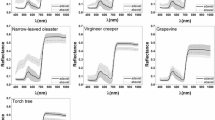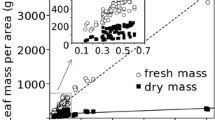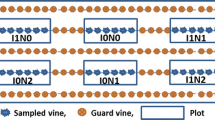Abstract
A field experiment of 18 wheat cultivars of erectophile, planophile and horizontal canopy architectures was conducted during the 2004–2005 growing seasons in Beijing (40°10.6′ N, 116°26.3′ E), China. Canopy reflectance (350–2500 nm) at different growth stages was measured and leaf area index (LAI) and leaf chlorophyll concentration (Chl) were determined at booting. The main objective of the study was to evaluate the ability of various vegetative indices (VIs) to detect canopy architectures in wheat genotypes. The chlorophyll-sensitive spectral indices, the modified chlorophyll absorption reflectance index (MCARI) and the transformed chlorophyll absorption reflectance index (TCARI), were very sensitive to canopy architectures in the wheat plants. The MCARI values were significantly (p < 0.05) larger for the horizontal genotypes than for the planophile ones, and also larger for the planophile genotypes than for the erectophile ones for the six growth stages. The TCARI had a similar power to MCARI for discriminating between different wheat canopy architectures. At booting, both MCARI and TCARI were only weakly related to Chl in the upper, middle and lower leaves. The results emphasized the difficulties of determining crop Chl from canopy reflectance. The mechanisms that cause the differences in MCARI and TCARI among the canopy architectures are discussed.


Similar content being viewed by others
References
Baret, F., & Guyot, G. (1991). Potentials and limits of vegetation indices for LAI and APAR assessment. Remote Sensing of Environment, 35, 161–173.
Daughtry, C. S. T., Walthall, C. L., Kim, M. S., Brown de Colstoun, E., & McMurtrey, J. E., III (2000). Estimating corn leaf chlorophyll concentration from leaf and canopy reflectance. Remote Sensing of Environment, 74, 229–239.
Galvão, L. S., Formaggio, A. R., & Tisot, D. A. (2005). Discrimination of sugarcane varieties in Southeastern Brazil with EO-1 Hyperion data. Remote Sensing of Environment, 94, 523–534.
Haboudane, D., Miller, J. R., Tremblay, N., Zarco-Tejada, P. J., & Dextraze, L. (2002). Integrated narrow-band vegetation indices for prediction of crop chlorophyll content for application to precision agriculture. Remote Sensing of Environment, 81, 416–426.
Hammer, G. L., Dong, Z. S., McLean, G., Doherty, A., Messina, C., Schusler, J., et al. (2009). Can changes in canopy and/or root system architecture explain historical maize yield trends in the US Corn Belt? Crop Science, 49, 299–312.
Huang, W. J., Niu, Z., Wang, J. H., Liu, L. Y., Zhao, C. J., & Liu, Q. (2006). Identifying crop leaf angle distribution based on two-temporal and bidirectional canopy reflectance. IEEE Transactions on Geoscience and Remote Sensing, 44, 3601–3609.
Lichtenthaler, H. K. (1987). Chlorophylls and caroteniods: Pigments of photosynthetic membranes. Methods of Enzymology, 148, 350–382.
Peñuelas, J., Baret, F., & Filella, I. (1995a). Semiempirical indexes to assess carotenoids and chlorophyll-a ratio from leaf spectral reflectance. Photosynthetica, 31, 221–230.
Peñuelas, J., Filella, I., & Gamon, J. A. (1995b). Assessment of photosynthetic radiation-use efficiency with spectral reflectance. New Phytologist, 13, 291–296.
Pinter, P. J., Jr., Jackson, R. D., Ezra, C. E., & Gausman, E. W. (1985). Sun-angle and canopy-architecture effects on the spectral reflectance of six wheat cultivars. International Journal of Remote Sensing, 6, 1813–1825.
Rondeaux, G., Steven, M., & Baret, F. (1996). Optimisation of soil-adjusted vegetation indices. Remote Sensing of Environment, 55, 95–107.
Rouse, J. W., Haas, R. H., Schell, J.A., & Deering, D. W. (1973). Monitoring vegetation systems in the Great Plains with ERTS. In Proceedings of third ERTS-1 symposium, Washington, DC, 10–14 December, NASA, SP-351 (Vol. 1, pp. 309–317). Washington, DC: Goddard Space Flight Center.
San-Oh, Y., Kond, M., Ookawa, T., & Hirasawa, T. (2008). Ecophysiological analysis on effect of planting pattern on biomass production and grain yield in rice. JARQ-Japan Agricultural Research Quarterly, 42, 79–89.
San-oh, Y., Mano, Y., Ookawa, T., & Hirasaw, T. (2004). Comparison of dry matter production and associated characteristics between direct-sown and transplanted rice plants in a submerged paddy field and relationships to planting patterns. Field Crops Research, 87, 43–58.
Sinclair, T. R., & Sheehy, J. E. (1999). Erect leaves and photosynthesis in rice. Science, 283, 1455.
Takahashi, T., & Nakaseko, K. (1993). Seasonal changes in distribution of intercepted photosynthetically radiation for layer and dry matter production in spring wheat canopy. Japanese Journal of Crop Science, 62, 313–318.
Wells, J. M., & Norman, J. M. (1991). Instrument for indirect measurement of canopy architecture. Agronomy Journal, 83, 818–825.
Zadoks, J. C., Chang, T. T., & Konzak, C. F. (1974). A decimal code for the growth stage of cereals. Weed Research, 14, 415–421.
Zheng, B. Y., Shi, L. J., Ma, Y. T., Deng, Q. Y., Li, B. G., & Guo, Y. (2008). Comparison of architecture among different cultivars of hybrid rice using a spatial light model based on 3-D digitising. Functional Plant Biology, 35, 900–910.
Acknowledgement
This work was subsidized by the National High Tech R&D Program of China (2006AA10A302, 2007AA10Z202), National Natural Science Foundation of China (40701119), and Special Funds for Major State Basic Research Project (2007CB714406). The authors are grateful to Mr. Weiguo Li, and Mrs. Hong Chang for data collection. They would also like to thank the three reviewers and the editor for the improvement of this paper.
Author information
Authors and Affiliations
Corresponding author
Rights and permissions
About this article
Cite this article
Zhao, C., Wang, J., Huang, W. et al. Spectral indices sensitively discriminating wheat genotypes of different canopy architectures. Precision Agric 11, 557–567 (2010). https://doi.org/10.1007/s11119-009-9148-7
Published:
Issue Date:
DOI: https://doi.org/10.1007/s11119-009-9148-7




